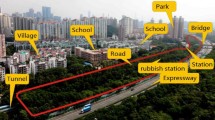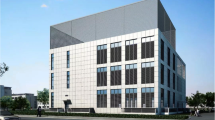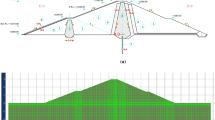Abstract
In this study, the influence of a vertical load on the deformation of a suspended plastic cutoff wall and the evolution of the piping of a dike foundation were studied through model tests and numerical analysis methods. The results of the numerical analysis were in good agreement with those of the model tests. Under vertical load and seepage force, the suspended plastic cutoff wall has well co-deformation with soil, and the mud permeable zone plays the role of “bridge”; the vertical load can increase the critical hydraulic gradient and failure hydraulic gradient and the corresponding upstream waterhead of dike foundation, and the influence of failure hydraulic gradient is greater than that of critical hydraulic gradient. In addition, the numerical analysis method obtains the distribution and variation in the hydraulic gradient along the piping channel from the pre-set orifice to the inlet, which provides reliable data support for the analysis of the evolution mechanism of dike foundation piping. The study also proves that the mud penetration belt plays a synergistic and auxiliary role in the prevention of dike foundation piping by the suspended cutoff wall, which provides strong support for further understanding of the mechanism of preventing dike foundation piping by the cutoff wall.














Similar content being viewed by others
Availability of Data and Materials
The datasets used and/or analyzed during the current study are available from the corresponding author on reasonable request.
References
Foster M, Fell R, Spannagle M (2000) The statistics of embankment dam failures and accidents. Can Geotech J 37(5):1000–1024. https://doi.org/10.1139/t00-030
Ma W, Zhang G, Yang Y, Wang P, Zhao Y, Lin Q (2022) The Piping Failure Mechanism of a Loess Dam: The 2021 Dam Break of the Yang Village Reservoir in China. Front Earth Sci. https://doi.org/10.3389/FEART.2022.892179
Xiao Q (2022) Impact of Piping Erosion Process on the Temporal-Spatial Mechanisms of Soil. Water 14(18):2841–2841. https://doi.org/10.3390/W14182841
Mitsu O, Yusuke T, Norihiro I, Kenichi M (2022) Centrifuge modeling of scale effect on hydraulic gradient of backward erosion piping in uniform aquifer under river levees. Soils Foundations. https://doi.org/10.1016/J.SANDF.2022.101214
Gao J, Dang J, Han X, Fang J, Ren J, Tian W (2022) A Study on the Generation Mechanism and Development Process of Piping Based on the Theory of Muddy Water Seepage. Geofluids. https://doi.org/10.1155/2022/6987524
Hoffmans GJCM (2022) Influence of hydraulic flow regime on backward erosion piping. J Hydraul Res 60(4):667–674. https://doi.org/10.1080/00221686.2021.2022027
Zhang CH, Ji EY, Wang BT (2021) Research on a Critical Hydraulic Gradient of Piping in Noncohesive Soils. Adv Civil Eng. https://doi.org/10.1155/2021/6217101
Wang Y, Li C, Zhou X, Wei X (2017) Seepage Piping Evolution Characteristics in Bimsoils—An Experimental Study. Water 9(7):458–458. https://doi.org/10.3390/w9070458
Wang S, Chen J-S, He H-Q, He W-Z (2016) Experimental study on piping in sandy gravel foundations considering effect of overlying clay. Water Sci Eng 9(2):165–171. https://doi.org/10.1016/j.wse.2016.06.001
Wang S, Chen J, Sheng J, Luo Y (2016) Laboratory investigation of stress state and grain composition affecting internal erosion in soils containing a suspended cut-off wall. KSCE J Civ Eng 20(4):1283–1293. https://doi.org/10.1007/s12205-015-0719-z
Rice JD, Duncan MJ (2010) Deformation and Cracking of Seepage Barriers in Dams due to Changes in the Pore Pressure Regime. J Geotech Geoenviron Eng 136(1):16–25. https://doi.org/10.1061/(ASCE)GT.1943-5606.0000241
Rice JD, Duncan MJ (2010) Findings of Case Histories on the Long-Term Performance of Seepage Barriers in Dams. J Geotech Geoenviron Eng 136(1):2–15. https://doi.org/10.1061/(ASCE)GT.1943-5606.0000175
Wen L, Cao W, Li Y, Liu Y, Zhou H (2022) Quantitative study on the influence of foundation valley shape on the behaviour of concrete cut-off walls. Structures. https://doi.org/10.1016/J.ISTRUC.2022.02.041
Karaulov AM, Korolev KV, Konkov AN, Yagofarov AK (2022) Horizontal Pressure Reduction on the Underground Contour of the Structure by Means of a Cut-Off Wall. Transport Res Proc. https://doi.org/10.1016/J.TRPRO.2022.01.103
Jin G, Xu H, Zhou A, Jiang P (2021) Permeability of soil-bentonite cut-off wall backfill material. Mater Lett. https://doi.org/10.1016/J.MATLET.2021.130775
Wen L (2018) A statistical analysis on concrete cut-off wall behaviour. Proc Instit Civil Eng Geotech Eng 171(2):160–173. https://doi.org/10.1680/jgeen.17.00142
Mehran J, Reza M, Mohammad HSMM (2018) Investigating the Influence of Penetration Length of Cut-off Wall on its Dynamic Interaction with Core and Foundation of Earth Dam. Civil Eng J 4(12):3019–3019. https://doi.org/10.28991/cej-03091217
Luo G-Y, Hong C (2006) Using zero-thickness elements to simulate suspended cut-off walls in a regional seepage field. Comput Geotech 33(6):305–315. https://doi.org/10.1016/j.compgeo.2006.07.004
Moffat RM, Fannin RJFJ (2011) A hydromechanical relation governing internal stability of cohesionless soil. Can Geotech J 48(3):413–424. https://doi.org/10.1139/T10-070
Li M, Fannin RJ (2012) A theoretical envelope for internal instability of cohesionless soil. Géotechnique 62(1):77–80. https://doi.org/10.1680/geot.10.T.019
Bendahmane F, Marot D, Alexis A (2008) Experimental Parametric Study of Suffusion and Backward Erosion. J Geotech Geoenviron Eng 134(1):57–67. https://doi.org/10.1061/(ASCE)1090-0241(2008)134:1(57)
Richards KS, Reddy KR (2012) Experimental investigation of initiation of backward erosion piping in soils. Géotechnique 62(10):933–942. https://doi.org/10.1680/geot.11.P.058
Richards KS, Reddy KR (2009) True Triaxial Piping Test Apparatus for Evaluation of Piping Potential in Earth Structures. Geotech Test J 33(1):102246–102246. https://doi.org/10.1520/GTJ102246
Ming X, Nathan S (2012) Experimental Investigation of the Effects of Suffusion on Physical and Geomechanic Characteristics of Sandy Soils. Geotech Test J 35(6):890–900. https://doi.org/10.1520/GTJ104594
Takahashi A, Ke L (2014) Triaxial Erosion Test for Evaluation of Mechanical Consequences of Internal Erosion. Geotech Test J 37(2):347–364. https://doi.org/10.1520/GTJ20130049
Wang S, Chen J-S, Luo Y-L, Sheng J-C (2014) Experiments on internal erosion in sandy gravel foundations containing a suspended cutoff wall under complex stress states. Nat Hazards 74(2):1163–1178. https://doi.org/10.1007/s11069-014-1243-z
Chen J, Zhang C, Wang S, Zhang H, Yuan K (2017) Experimental Study on the Impacts of Suspended Cut-off Wall in Embankment Piping Under Different Contents of the Fine Particles. Yellow River 39(1):41–46 (In Chinese)
Beek VMV (2015) Backward erosion piping: Initiation and progression: Delft University of Technology
Vandenboer K, Beek V, Bezuijen A (2014) 3D finite element method (FEM) simulation of groundwater flow during backward erosion piping. Front Struct Civ Eng 8(2):160–166. https://doi.org/10.1007/s11709-014-0257-7
Vandenboer K, Beek VMV, Bezuijen A (2018) 3D character of backward erosion piping. Géotechnique 68(1):86–90. https://doi.org/10.1680/jgeot.16.P.091
Acknowledgements
Thanks to Professor Han-Dong Liu and North China University of Water Resources and Electric Power for the help and project support.
Funding
This study was supported by the National Natural Science Foundation of China (NO. U1704243) and the National Natural Science Foundation of China (NO. 52179133).
Author information
Authors and Affiliations
Contributions
L-YF: writing the manuscript, experimental works, analyzing data, reviewing, editing. H-DL and J-XC: review and comments. All authors read and approved the final manuscript.
Corresponding author
Ethics declarations
Conflict of interest
The authors declare that they have no competing interests.
Rights and permissions
Springer Nature or its licensor (e.g. a society or other partner) holds exclusive rights to this article under a publishing agreement with the author(s) or other rightsholder(s); author self-archiving of the accepted manuscript version of this article is solely governed by the terms of such publishing agreement and applicable law.
About this article
Cite this article
Feng, LY., Liu, HD. & Chen, JX. Experimental Study on Piping of Dike Foundation with Suspended Plastic Cutoff Wall Under Vertical Load. Int J Civ Eng 22, 523–533 (2024). https://doi.org/10.1007/s40999-023-00909-2
Received:
Revised:
Accepted:
Published:
Issue Date:
DOI: https://doi.org/10.1007/s40999-023-00909-2




